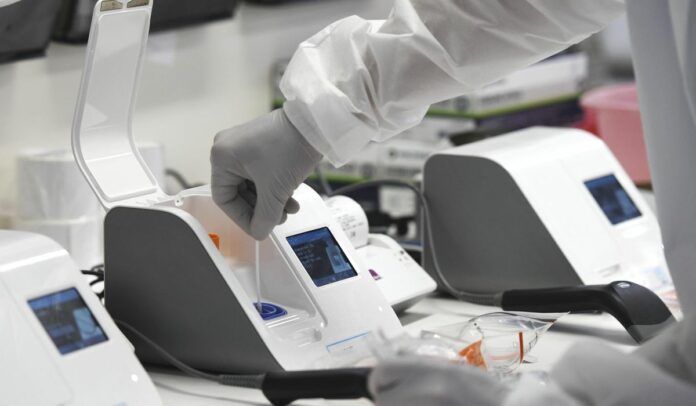Blood clots that lead to stroke or sudden death. A loss of taste and smell. Inflammation in children and infants. The risk of transmission from loud talking.
These are some of the things we’ve learned with some surety about the new coronavirus in the half year since it popped up in a central Chinese metropolis.
It has become a running joke — a frustration, really — that so little is known about the newly discovered pathogen.
Yet scientists are slowly putting together pieces of the puzzle.
U.S. scientists say one critical part of their efforts to decode the virus was realizing that people without symptoms can be highly contagious. It’s why health officials are pleading with Americans to wear masks in public as economies reopen and people delight in all summer has to offer.
“We had the view from our Chinese colleagues in their early experience, and our early experience, that this was a symptomatic disease like most respiratory viral diseases were. But what we rapidly started to learn is there’s significant asymptomatic infection or what we would call pre-symptomatic infection,” Robert Redfield, the director of the Centers for Disease Control and Prevention, told Congress at a recent hearing.
Officials realized that if these people “were wearing a face covering, that they would have less ability to transmit to others. And that’s why we embrace this important public health tool. And I will say that we continue to see this as a critical public health tool.”
The World Health Organization offered a dissenting voice Monday, saying spread by an asymptomatic person can happen but is “rare.”
“It still appears to be rare that asymptomatic individuals actually transmit onward,” said Maria Van Kerkhove, WHO’s technical lead on COVID-19.
Indeed, scientists appear to say or learn something new about the disease each week, underscoring the six short months that humans have interacted with the virus.
The early days of the pandemic, which has infected nearly 2 million people and killed over 110,000 in the U.S., featured a scramble to understand the basics of COVID-19. Global officials leaned on China to confirm a vital fact: The disease could spread from human to human.
As it spread, certain contours emerged. It hit the elderly and medically vulnerable the hardest, resulting in an outsized impact on nursing homes and minority populations with high rates of pre-existing medical conditions.
“We’ve learned a lot,” President Trump said during a May tour of a Ford Motor plant. “If you’re a certain age, you have a problem with diabetes or you have a problem with your heart, you’re a prime suspect for this horrible disease.”
Disease trackers also realized that carriers of the coronavirus were “seeding” metropolitan areas like New York not just from China but from hot spots in Europe. The Trump administration restricted travel from China at the start of February but waited until mid-March to limit European travel.
New York Gov. Andrew Cuomo said the U.S. slammed the front door shut “but we left the back door open.”
Once the disease became widespread, patients began to describe their experiences on social media and elsewhere.
One revelation? People who got COVID-19 seemed to lose their sense of smell and taste, leading some experts to say it should be added to the list of symptoms to use for diagnosis.
Others have reported difficulty exercising after recovery, suggesting the effects can be long-lasting even after the virus is cleared.
Some patients are experiencing post-intensive care syndrome, or PICS, which is the result of critical illness and treatment such as mechanical ventilation and sedation. It can lead to cognitive trouble, weakness and difficulty tackling daily tasks. Some will have lasting lung damage and shortness of breath.
By late April and early May, doctors were reporting blood clots, especially in young people, that led to debilitating strokes.
“We definitely now know that COVID-19 can cause a constellation of clinical syndromes that can include such complications as blood clotting, leading to stroke and pulmonary embolism, and cardiac dysfunction,” said Amesh Adalja, a senior scholar at the Johns Hopkins Center for Health Security.
The virus appeared to grant one blessing: Children and infants were largely spared. Yet that changed by mid-May when New York public health officials spotted a strange syndrome, akin to Kawasaki disease, in children with coronavirus antibodies, suggesting a link to the virus. The problem affected over 100 children and killed at least five.
“Children aren’t affected? Oh, really? Now it’s another fact that they’re going to change on us,” Mr. Cuomo fumed at one of his daily coronavirus briefings.
Despite near-weekly revelations about COVID-19, there is plenty we still don’t know. Scientists believe warmer, humid weather will knock down droplets that carry the coronavirus, slowing transmission, but the human population is so susceptible to the new disease that it might not matter much.
The world might provide a better picture as the Southern Hemisphere enters its winter and U.S. disease trackers look at places like Phoenix and Houston, which are still reporting rising case counts.
“So far, we haven’t seen an obvious impact of warm temperatures, but we are not yet in the summer months,” said Peter Hotez, dean of the National School of Tropical Medicine at the Baylor College of Medicine.
Other unknowns include how the disease hopped to humans in the first place — or when — and why some people end up on a ventilator while others feel barely anything at all.
“There are many unknowns that still exist regarding COVID-19. There is still no determination of which intermediate animal likely spread this to humans,” said Dr. Adalja. “We do not know exactly when it spread to humans in the fall of 2019. We do not understand how far widespread it became before it was noticed in other countries. We don’t fully understand the risk factors for severe disease or complications.”






